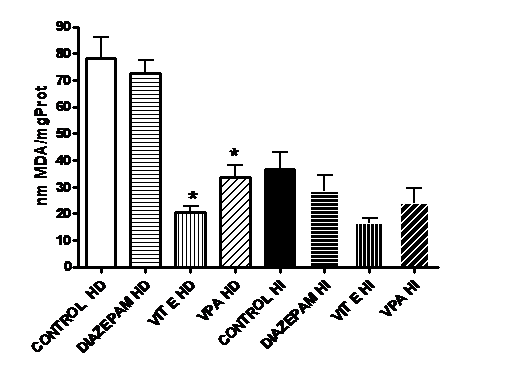El ácido valproico tiene efecto neuroprotector en un modelo de estrés oxidativo agudo en ratas
Palabras clave:
ácido valproico, radicales libres, corteza cerebral, neuroprotecciónResumen
El exceso de producción de radicales libres en el cerebro ha sido implicada como un factor común en la patogénesis de un gran número de procesos neurodegenerativos, incluyendo la enfermedad de Alzheimer, la enfermedad de Parkinson, y en la isquemia/reperfusión cerebral. El ácido valproico (VPA) que tradicionalmente ha sido utilizado como fármaco antiepiléptico, actualmente se propone como agente neuroprotector, pero aún no está claro cual es su mecanismo de acción. En esta investigación se probó su efecto en un modelo de estrés oxidativo agudo en ratas Sprague Dawley para lo cual se usó el sulfato de hierro como agente inductor de daño y se cuantificó la peroxidación lipídica y proteínas carboniladas en corteza cerebral, demostrándose que bloqueó la formación de radicales libres. Los niveles de malondialdehído en la corteza cerebral que recibió la agresión oxidativa en el grupo de animales tratados con VPA fueron 57% inferiores en relación al grupo control que no recibió VPA, mientras que la cantidad de proteínas carboniladas fue un 65% inferior en la corteza cerebral de los animales experimentales en comparación al grupo control. Adicionalmente se encontró que el efecto antioxidante exhibido por el VPA, fue igual de significativo al presentado por la vitamina E.
Descargas
Citas
[2] Halliwell B. Oxidative stress and neurodegeneration: where are we now? J Neurochem 2006; 97:1634-1658.
[3] Beckman KB, Ames BN. The free radical theory of aging matures. Physiol Rev 1998; 78:547-581.
[4] Harman AW, Maxwell MJ. An evaluation of the role of calcium in cell injury. Annu Rev Pharmacol Toxicol 1995; 35:129-144.
[5] Ratnam DV, Ankola DD, Bhardwaj V, Sahana DK, Kumar MN. Role of antioxidants in prophylaxis and therapy: a pharmaceutical perspective. J Control Release 2006; 113: 189-207.
[6] Pandya RS, Mao L, Zhou H, Zhou S, Zeng J, Popp AJ, Wang X. Central nervous system agents for ischemic stroke: neuroprotection mechanisms. Cent Nerv Syst Agents Med Chem 2011; 11(2):81-97.
[7] Qian YR, Lee MJ, Hwang S, Kook JH, Kim JK, Bae CS. Neuroprotection by valproic Acid in mouse models of permanent and transient focal cerebral ischemia. Korean J Physiol Pharmacol 2010; 14(6):435-440.
[8] Chiossi L, Negro A, Capi M, Lionetto L, Martelletti P. Sodium channel antagonists for the treatment of migraine. Expert Opin Pharmacoth 2014; 15(12):1697-706.
[9] Monti B, Polazzi E, Contestabile A. Biochemical, molecular and epigenetic mechanisms of valproic acid neuroprotection. Curr Mol Pharmacol 2009; 2(1):95-109.
[10] Ohkawa H, Ohishi N, Yagi K. Assay for lipid peroxides in animal tissues by thiobarbituric acid reaction. Anal Biochem 1979; 95(2):351-358.
[11] Levine RL, Garland D, Oliver CN, Amici A, Climent I, Lenz AG, et al. Determination of carbonyl content in oxidatively modified proteins. Methods Enzymol 1990; 186:464-478.
[12] Lowry, O. H., Rosebrough NJ, Farr AL, Randall RJ. Protein measurement with the Folin phenol reagent. J Biol Chem, 1951. 193(1):265-275.
[13] Chang TK, Abbott FS. Oxidative stress as a mechanism of valproic acid-associated hepatotoxicity. Drug Metab Rev 2006; 38(4):627-639.
[14] Chaudhary S, Parvez S. An in vitro approach to assess the neurotoxicity of valproic acid-induced oxidative stress in cerebellum and cerebral cortex of young rats. Neuroscience 2012; 225:258-268.
[15] Choi DW, Rothman SM. The role of glutamate neurotoxicity in hypoxic-ischemic neuronal death. Annu Rev Neurosci 1990; 13:171-182.
[16] De Keyser J, Sulter G, Luiten PG. Clinical trials with neuroprotective drugs in acute ischaemic stroke: are we doing the right thing? Trends Neurosci 1999; 22(12):535-540.
[17] Löscher W, Schmidt D. Increase of human plasma GABA by sodium valproate. Epilepsia 1980; 21(6):611-615.
[18] Madden K, Clark W, Lessov N. Failure of ischemic neuroprotection by potentiators of gamma-aminobutyric acid.Clin Med Res 2003; 1(2):119-124.
[19] Wang JF, Azzam JE, Young LT. Valproate inhibits oxidative damage to lipid and protein in primary cultured rat cerebrocortical cells. Neuroscience 2003; 116(2):485-489.
[20] Bjørneboe A, Bjørneboe GE, Drevon CA. Absorption, transport and distribution of vitamin E. J Nut 1990; 120(3):233-242.
[21] Frey BN, Valvassori SS, Réus GZ, Martins MR, Petronilho FC, Bardini K, et al. Effects of lithium and valproate on amphetamine-induced oxidative stress generation in an animal model of mania. J Psychiatry Neurosci 2006; 31(5):326-332.

Publicado
Cómo citar
Número
Sección
Gaceta de Ciencias Veterinarias se apega al modelo Open Access, por ello no se exige suscripción, registro o tarifa de acceso a los usuarios o instituciones. Los usuarios pueden leer, descargar, copiar, distribuir, imprimir y compartir los textos completos inmediatamente después de publicados, se exige no hacer uso comercial de las publicaciones. Para la reproducción parcial o total de los trabajos o contenidos publicados, se exige reconocer los derechos intelectuales de los autores y además, hacer referencia a esta revista. La publicación de artículos se hace sin cargo para los autores. Los trabajos pueden consultarse y descargarse libremente, y de manera gratuita, en extenso en versión digital, desde su enlace Web institucional. Los textos publicados son propiedad intelectual de sus autores. Las ideas, opiniones y conceptos expuestos en los trabajos publicados en la revista representan la opinión de sus autores, por lo tanto, son estos los responsables exclusivos de los mismos.


